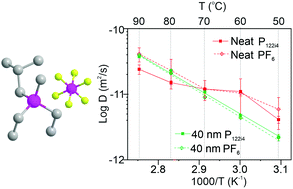Decoupled ion mobility in nano-confined ionic plastic crystal†
Abstract
Nanoconfined ions have dramatically different local environments compared to the bulk, which profoundly affects the ion solvation and transport properties taking place in the confined space. Herein, we investigate the rotational and translation mobility of both cation and anions of an OIPC (diethyl)(methyl)(isobutyl)phosphonium hexafluorophosphate) confined in 40 and 180 nm straight-through Al2O3 pores. The results revealed that the nanoconfined OIPC exhibit 44 times higher ionic conductivity than the bulk material at 30 °C. This enhancement is attributed to both the reduced tortuosity and the increased population of mobile species. More interestingly, the Al2O3 nanochannels were found to selectively enhance the rotation and translational motion of [P122i4] cation at elevated temperatures, whilst leaving that of the [PF6] anion less affected.



 Please wait while we load your content...
Please wait while we load your content...